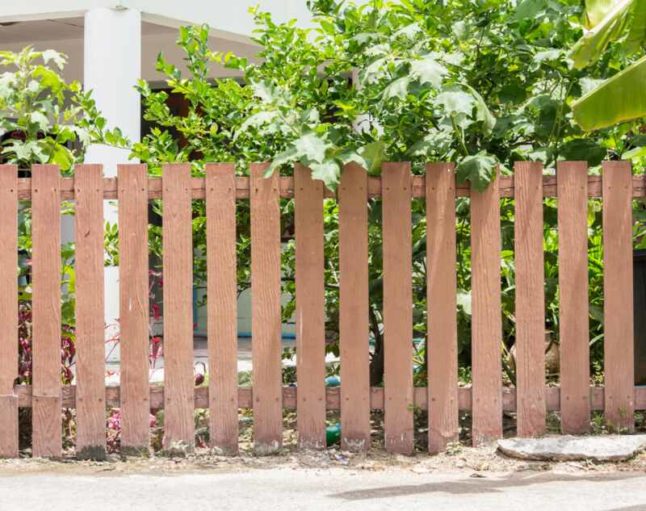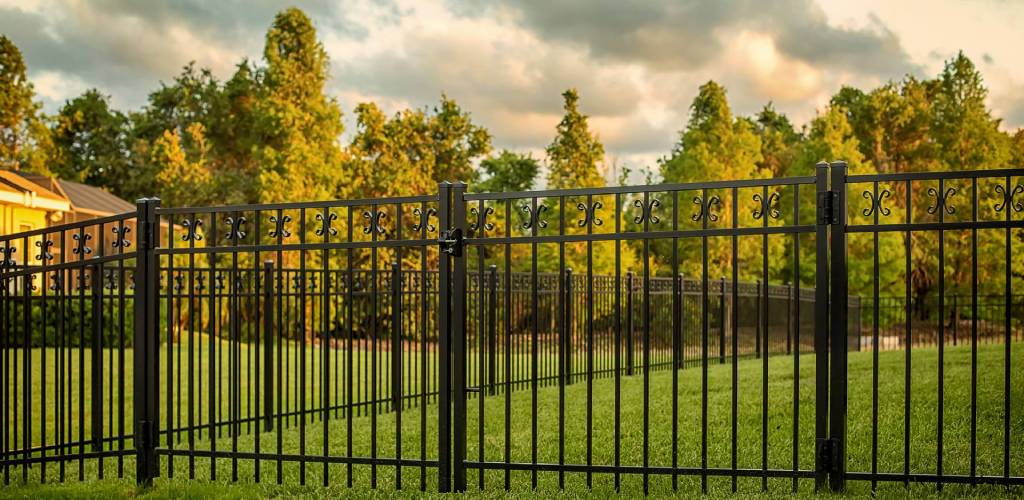Featured
When it pertains to securing your residential or commercial property, selecting the proper fence height is a crucial choice. A correctly picked fencing can serve as an effective deterrent against trespassers and improve the general safety of your home or organization. However selecting the appropriate elevation includes several elements, consisting of neighborhood policies, your particular security demands, and the kind of fence you are thinking about. Here's an in-depth guide to aid you establish the optimum fencing height for protecting your residential property.
![]()
In some instances, homeowners may require a license to construct a fence over a particular height. To stay clear of lawful problems or fines, constantly check with your local authorities prior to waging installment. Additionally, if you reside in an area governed by a house owners' association (HOA), be certain to examine their standards, as they might have certain regulations concerning fencing height and style.
In more high-risk areas, or if you have beneficial property or are dealing with security concerns, you may desire to take into consideration an also taller fence-- approximately 8 feet or greater. A taller fence is extra daunting to possible burglars and offers a much better physical obstacle. If you wish to go also further, consider adding security functions like razor cord, electrical fence, or sharp latticework tops, which can make the fencing also much more tough to violation.
Wood Fencings: Wood fencings supply personal privacy, but they can be relatively easy to climb up. An elevation of 6 to 8 feet is recommended for appropriate safety. To boost deterrence, think about including pointed tops or mounting a trellis with climbing up plants. Wrought Iron Fences: Wrought iron fences are tough and durable to climb. They're often used for higher-security objectives and can be constructed in between 6 to 8 feet tall. The vertical bars, particularly when topped with points or spikes, work as a formidable obstacle. Chain-Link Fences: A chain-link fence that's 6 to 8 feet tall can offer a cost-effective and useful solution. Adding attributes like barbed cord or razor cord at the top can raise protection substantially. Vinyl Fencings: Plastic fencings can additionally use personal privacy and protection, but like wooden fencings, they may need extra elevation and features to avoid climbing. A solid plastic fencing of 6 to 8 feet in elevation can be extremely reliable at keeping unwanted site visitors out. 4. Privacy vs. Safety. If your primary issue is privacy, a taller, strong fencing (like wood or vinyl) might be the most effective choice. Taller fences block the view from the outside, ensuring that trespassers can not easily evaluate your building or spot prized possessions. Personal privacy fences of 6 to 8 feet are typical for this objective.
However, if security is more of a worry than personal privacy, you might wish to choose a fence material that supplies exposure, such as chain-link, while still being tall enough to prevent climbing. The benefit of this approach is that it enables you to watch on activity outside your residential or commercial property and make it much more challenging for a person to method unnoticed.
![]()
Anti-Climb Functions: Installing anti-climb spikes or trellis expansions on top of your fencing will make it also much more challenging for trespassers to scale it. These can be especially effective on wood or vinyl fences. Razor Wire or Barbed Wire: If safety is a considerable issue, including razor cable or barbed cable to the top of your fence is a highly reliable deterrent. These attributes can be combined with a solid wooden or chain-link fencing for maximum defense. Electric Fence: For increased protection, electric fence can be set up on top of an existing fence. While these need special installation and an expert to guarantee safety, they can be really reliable in avoiding unapproved accessibility to your property. 6. Aesthetic Factors to consider. While security is the primary objective, it's also essential to think of how the fence will look. Some communities or areas might have aesthetic standards or HOA guidelines, so choosing a fence that matches your building's design while still providing safety is essential. Deciding for a fencing that blends right into the atmosphere and fits the architectural style of your home can make certain that your fence is both visually enticing and practical.
Verdict. When choosing a fence height for optimal protection, go for an equilibrium between elevation, material, and added safety features to best satisfy your requirements. A height of 6 to 8 feet is typically enough for the majority of properties, but if you reside in a risky area or have details safety concerns, taller fences with included functions like spikes or electrical systems may be needed. Do not fail to remember to review local regulations and HOA guidelines to ensure your fencing adheres to area standards. By taking into consideration these aspects, you can choose a fencing height that improves both the safety and visual value of your property.
- Understand Regional Laws and Laws. Prior to you purchase a brand-new fence, it's vital to be mindful of the neighborhood zoning laws and building ordinance that may dictate the maximum height for fence your area. Lots of communities have constraints on the height of fences, particularly for front lawns, where fences are often limited to 3 to 4 feet. In backyards, nevertheless, you may be allowed to develop taller fences, generally ranging from 6 to 8 feet.

In some instances, homeowners may require a license to construct a fence over a particular height. To stay clear of lawful problems or fines, constantly check with your local authorities prior to waging installment. Additionally, if you reside in an area governed by a house owners' association (HOA), be certain to examine their standards, as they might have certain regulations concerning fencing height and style.
- Think about the Degree of Protection You Required. The elevation of your fence straight associates with the degree of security it gives. A fencing that's also short may be simple to climb up over or bypass, making it inadequate in shutting out intruders. For greater safety, aim for a fencing height of at the very least 6 feet, which is normally sufficient to stop most people from easily scaling it.
In more high-risk areas, or if you have beneficial property or are dealing with security concerns, you may desire to take into consideration an also taller fence-- approximately 8 feet or greater. A taller fence is extra daunting to possible burglars and offers a much better physical obstacle. If you wish to go also further, consider adding security functions like razor cord, electrical fence, or sharp latticework tops, which can make the fencing also much more tough to violation.
- Pick the Right Fence Material. Various fencing products offer varying levels of security, and the height of the fence should be matched with the material's sturdiness. For instance:
Wood Fencings: Wood fencings supply personal privacy, but they can be relatively easy to climb up. An elevation of 6 to 8 feet is recommended for appropriate safety. To boost deterrence, think about including pointed tops or mounting a trellis with climbing up plants. Wrought Iron Fences: Wrought iron fences are tough and durable to climb. They're often used for higher-security objectives and can be constructed in between 6 to 8 feet tall. The vertical bars, particularly when topped with points or spikes, work as a formidable obstacle. Chain-Link Fences: A chain-link fence that's 6 to 8 feet tall can offer a cost-effective and useful solution. Adding attributes like barbed cord or razor cord at the top can raise protection substantially. Vinyl Fencings: Plastic fencings can additionally use personal privacy and protection, but like wooden fencings, they may need extra elevation and features to avoid climbing. A solid plastic fencing of 6 to 8 feet in elevation can be extremely reliable at keeping unwanted site visitors out. 4. Privacy vs. Safety. If your primary issue is privacy, a taller, strong fencing (like wood or vinyl) might be the most effective choice. Taller fences block the view from the outside, ensuring that trespassers can not easily evaluate your building or spot prized possessions. Personal privacy fences of 6 to 8 feet are typical for this objective.
However, if security is more of a worry than personal privacy, you might wish to choose a fence material that supplies exposure, such as chain-link, while still being tall enough to prevent climbing. The benefit of this approach is that it enables you to watch on activity outside your residential or commercial property and make it much more challenging for a person to method unnoticed.
- Enhancing the Protection with Additional Features. The height of your fence is only one component of your total protection strategy. Take into consideration integrating additional features to enhance its effectiveness:

Anti-Climb Functions: Installing anti-climb spikes or trellis expansions on top of your fencing will make it also much more challenging for trespassers to scale it. These can be especially effective on wood or vinyl fences. Razor Wire or Barbed Wire: If safety is a considerable issue, including razor cable or barbed cable to the top of your fence is a highly reliable deterrent. These attributes can be combined with a solid wooden or chain-link fencing for maximum defense. Electric Fence: For increased protection, electric fence can be set up on top of an existing fence. While these need special installation and an expert to guarantee safety, they can be really reliable in avoiding unapproved accessibility to your property. 6. Aesthetic Factors to consider. While security is the primary objective, it's also essential to think of how the fence will look. Some communities or areas might have aesthetic standards or HOA guidelines, so choosing a fence that matches your building's design while still providing safety is essential. Deciding for a fencing that blends right into the atmosphere and fits the architectural style of your home can make certain that your fence is both visually enticing and practical.
Verdict. When choosing a fence height for optimal protection, go for an equilibrium between elevation, material, and added safety features to best satisfy your requirements. A height of 6 to 8 feet is typically enough for the majority of properties, but if you reside in a risky area or have details safety concerns, taller fences with included functions like spikes or electrical systems may be needed. Do not fail to remember to review local regulations and HOA guidelines to ensure your fencing adheres to area standards. By taking into consideration these aspects, you can choose a fencing height that improves both the safety and visual value of your property.
Latest Posts
Find the Premier Auto Repair Coupons in Montclare, Chicago
Published May 26, 25
1 min read
Uncover Montclare Auto Repair’s Highly Requested Car Care Solutions and Why Drivers Choose Them
Published May 25, 25
1 min read
Discover Your Financial Partner at WyHy – Top Benefits for Wyoming Residents
Published May 24, 25
1 min read
More
Latest Posts
Find the Premier Auto Repair Coupons in Montclare, Chicago
Published May 26, 25
1 min read
Uncover Montclare Auto Repair’s Highly Requested Car Care Solutions and Why Drivers Choose Them
Published May 25, 25
1 min read
Discover Your Financial Partner at WyHy – Top Benefits for Wyoming Residents
Published May 24, 25
1 min read